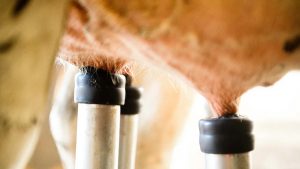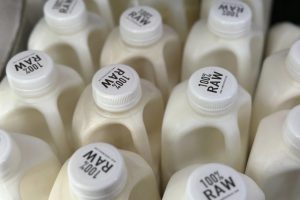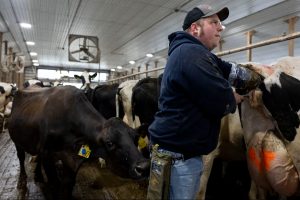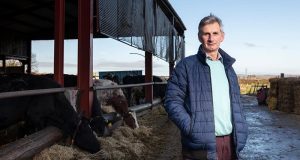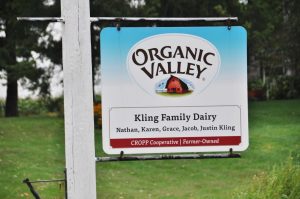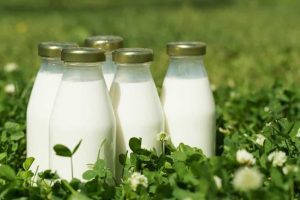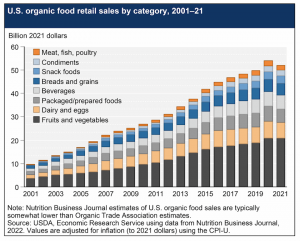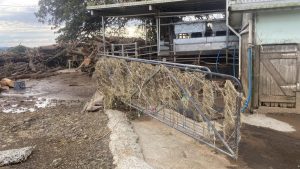
The Northeast Organic Dairy Producers Alliance (NODPA) recently held its annual Field Days, touring several organic dairy farms near Middlebury, Vermont, and hosting experts – including panels of organic dairy farmers – to discuss industry news, share concerns, offer solutions and promote the best practices for organic dairy success.
Herd health is always a topic of discussion for organic dairy farmers. NODPA maintains an active Listserve, Odairy, where prevention, diagnosis and treatment of herd health issues are often discussed. And at the Field Days, the “Ask the Vet” conference session featured veterinarians Dayna Locitzer from Green Mountain Bovine and Equine Clinic in New Hampshire and Elizabeth Martens of Valleywide Veterinary Services of Bridport, Vermont, who answered questions from dairy farming participants.
Ask the vet
One prominent concern voiced by producers was calf scours. Scours is not simply a disease caused by one pathogen. Instead, it is an illness caused by multiple pathogens, each of which predominates depending on the age of the calf.
“Certain pathogens show up at different times,” Locitzer said. “Identifying when you’re having the scours will help you with your management strategies.”
Escherichia coli, a bacteria, causes scours in calves up to 10 days old. Rotaviruses and coronaviruses, as well as cryptosporidium – a parasitic protozoa – tend to cause scours that appear from 10 days old to a few weeks old. After that timeframe, coccidia, which is an oocyte, is often the cause.
E. coli requires cleanliness in the maternity pen, as it lives in the intestinal tract and is transferred via feces. Cryptosporidium requires a “good immunity and a good nutritional plane” to combat, beginning – as always – with colostrum, Locitzer said.
A contributing factor to scours due to cryptosporidium is underfeeding milk to calves. At a minimum, calves require 10% of their bodyweight, preferably more, in milk each day, Locitzer said. That is at least a gallon of milk per feeding at 2 weeks old.
Calves have no immune system or antibodies of their own when born. Colostrum provides antibodies from the mother, protecting against calf scours no matter the pathogen. Another option to get antibodies into calves is to provide an oral antibody, such as First Defense Tri-Shield paste, which protects against early-life scours from rotavirus, coronavirus and E. coli, and should be given on day one, along with colostrum.
“So vaccination would be specifically vaccinating the cow, and then colostrum, or Tri-Shield, which is antibodies,” should be given to the calf to provide protection from scours in early life, Martens said.
Treating scours
Milk feeding should not be stopped when scours is present. Instead, smaller and more frequent feedings should occur. Electrolytes should be given – 2 quarts – as soon as calves show any signs of scours. The quality of electrolytes matters, and some mixes are better than others.
“When a calf has scours, she basically has four problems. She’s dehydrated. … She’s acidotic because the food in her gut that she’s not digesting is fermenting and causing a lot of acid, and also her diarrhea is full of base or bicarb,” Martens said. “They also have low blood sugar, and they tend to be cold.”
Scours leaves calves weak and not able to suck well. Providing nutrition, keeping them warm, and providing fluids and electrolytes to neutralize acids is required. Tubing a calf can work, but cannot be done on a calf that has no suckle reflex. The suckle reflex indicates the digestive tract is working. If it isn’t, IV fluids are needed instead.
Baking soda is very cost effective for adding a base, but feeding it orally is not the best option as it goes into the abomasum and can make the stomach less acidic so it can’t function properly. Instead, propionate and acetate are available in many commercial electrolyte mixes, and are allowed in organic production, and serve the same purpose of buffering excess acids.
During scours, lactase enzymes aren’t being made in the intestine, leading to temporary lactose intolerance. If allowed by the organic certifier – there are other ingredients in many of the commercial formulations – adding lactase is an inexpensive way to help calves digest milk and reduce fermentation of milk in the intestine. It won’t cure scours, but will help to maintain nutrition and to increase comfort, Martens said.
Pinkeye
“Vaccination is effective” but difficult due to at least three pathogenic agents commonly causing pinkeye, but the available vaccines each only cover one type of pathogen. And some pinkeye pathogens don’t have an effective vaccine.
Vaccination needs to be initiated prior to any exposure to risk factors, and – as with most vaccines – boosters are required. Full immunity should be achieved before flies and tall grass, which are the two primary risk factors for pinkeye, are encountered.
“A multi-pronged approach is really important,” in prevention, Locitzer said.
Pinkeye does occur in the absence of flies, which spread the pathogens, and it happens to non-grazing herds. Ultraviolet light, dust, blown bedding and any other means of damaging the cornea will allow bacteria to enter and grow in the eyes, Martens said.
Corneas don’t have a blood supply, so healing is complicated. Saline sprays help bring in healing factors found naturally in the body and reduce discomfort. Sewing the eyelids shut can help prevent UV light irritation when pinkeye is present. Taking serum from the sick cow – drawn from her blood into a red-topped tube and centrifuged, then drawing off the fluid from the top – to put into the eye will also provide healing factors and lubrication.
Antibiotics are not effective and only decrease the course of disease by a day or two, Locitzer said.
Skin deep
Ringworm is a fungal disease often contracted during weaning, when calves are under increased stress. It does not normally hurt the calves. Calves with lower immune status are the ones who contract the disease, Martens said.
Ringworm is not easily prevented. It lives in wood and tends to be opportunistic, selecting weaker calves. Ringworm can become bad enough to lead to death, but healthy cows should not succumb to severe cases of disease.
Ringworm lives outside of the immune system, on the skin. Getting the skin of the calf to bleed (while protecting yourself) can bring the immune system into play. Drying ringworm out with iodine works well. Kelp is a good source of iodine, and providing kelp during weaning, along with selenium and minerals, can be a preventative, protective measure. The disease itself is self-limiting to about six weeks, but the measures above can decrease the disease’s duration.
Happy lines and health
Slightly raised lines that are always present are a sign of good health, Locitzer and Martens agreed. They aren’t certain why they happen, and both conventional and organic cows in great health will have these lines. It seems to indicate a healthy coat, which is representative of overall well-being. Seeing these happy lines can provide producers with a general indication of good herd health.
Without a reliance on antibiotics, organic dairy farmers must focus on keeping the herd healthy. Good nutrition, clean environments and proactive, preventative measures all are a part of the tools organic dairy farmers have for prioritizing cow health. Vaccination, immune-enhancing probiotics and practices, natural healing and antimicrobial tinctures, and nutritional support are all means of establishing and maintaining herd health.




